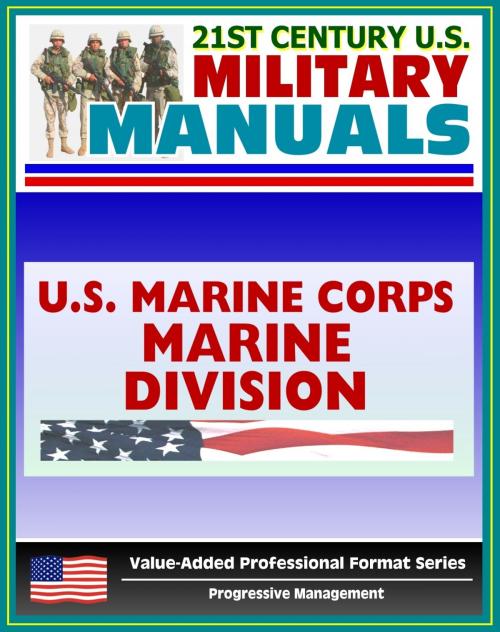21st Century U.S. Military Manuals: Marine Division Expeditionary Ground Combat Marine Corps Field Manual - FMFM 6-1 (Value-Added Professional Format Series)
Nonfiction, History, Military| Author: | Progressive Management | ISBN: | 9781465828415 |
| Publisher: | Progressive Management | Publication: | September 29, 2011 |
| Imprint: | Smashwords Edition | Language: | English |
| Author: | Progressive Management |
| ISBN: | 9781465828415 |
| Publisher: | Progressive Management |
| Publication: | September 29, 2011 |
| Imprint: | Smashwords Edition |
| Language: | English |
Part of our value-added professional format series, the Marine Division Expeditionary Ground Combat Marine Corps Field Manual (FMFM 6-1) describes the Marine division, a multirole, expeditionary ground combat force. The division is employed as the ground combat element (GCE) of the Marine Expeditionary Force (MEF) or may provide task-organized forces for smaller Marine Air-Ground Task Forces (MAGTFs). The MAGTF is a balanced combined arms team capable of a wide range of operations throughout the spectrum of war. The operations of the GCE are coordinated with those of the aviation combat element (ACE) and the combat service support element (CSSE) by the command element (CE) of the MAGTF.
The mission of the Marine division is to execute amphibious assault operations and such operations as may be directed. The Marine division must be able to provide the ground amphibious forcible entry capability to the naval expeditionary force (NEF) and conducting subsequent [and operations in any operational environment. The division commander fights using combined arms tactics and tailors the force to the demands of each mission.
The Marine division consists of organizations designed to provide command and control, maneuver, fire support, and logistic capabilities.
The primary mission of the headquarters battalion is to exercise command, control, and administration of the division. It contains a headquarters and service company; a division headquarters with a headquarters and service company; a reconnaissance company; a special security communications team; a communications company; a military police company; the division band; and a truck company.
The headquarters battalion contributes to the command and control (C2) of the division by providing the preponderance of C2 support assets, organic intelligence support, and facilities for the division headquarters. The principal providers of this support located in the headquarters battalion include the division headquarters, the headquarters and service company, the communications company, the special security communications team, and the reconnaissance company.
As a bonus, this reproduction includes FM-1, The Army Field Manual, a capstone manual containing the vision for the Army - sold separately for $5.99. FM 1 establishes the fundamental principles for employing Landpower. The most important of these are the Army's operational concept and the fundamentals that support it. They form the foundation for all Army doctrine. All Soldiers should understand and internalize them. FM 1 describes the American profession of arms, the Army's place in it, and what it means to be a professional Soldier.
This is a privately authored news service and educational publication of Progressive Management.
Part of our value-added professional format series, the Marine Division Expeditionary Ground Combat Marine Corps Field Manual (FMFM 6-1) describes the Marine division, a multirole, expeditionary ground combat force. The division is employed as the ground combat element (GCE) of the Marine Expeditionary Force (MEF) or may provide task-organized forces for smaller Marine Air-Ground Task Forces (MAGTFs). The MAGTF is a balanced combined arms team capable of a wide range of operations throughout the spectrum of war. The operations of the GCE are coordinated with those of the aviation combat element (ACE) and the combat service support element (CSSE) by the command element (CE) of the MAGTF.
The mission of the Marine division is to execute amphibious assault operations and such operations as may be directed. The Marine division must be able to provide the ground amphibious forcible entry capability to the naval expeditionary force (NEF) and conducting subsequent [and operations in any operational environment. The division commander fights using combined arms tactics and tailors the force to the demands of each mission.
The Marine division consists of organizations designed to provide command and control, maneuver, fire support, and logistic capabilities.
The primary mission of the headquarters battalion is to exercise command, control, and administration of the division. It contains a headquarters and service company; a division headquarters with a headquarters and service company; a reconnaissance company; a special security communications team; a communications company; a military police company; the division band; and a truck company.
The headquarters battalion contributes to the command and control (C2) of the division by providing the preponderance of C2 support assets, organic intelligence support, and facilities for the division headquarters. The principal providers of this support located in the headquarters battalion include the division headquarters, the headquarters and service company, the communications company, the special security communications team, and the reconnaissance company.
As a bonus, this reproduction includes FM-1, The Army Field Manual, a capstone manual containing the vision for the Army - sold separately for $5.99. FM 1 establishes the fundamental principles for employing Landpower. The most important of these are the Army's operational concept and the fundamentals that support it. They form the foundation for all Army doctrine. All Soldiers should understand and internalize them. FM 1 describes the American profession of arms, the Army's place in it, and what it means to be a professional Soldier.
This is a privately authored news service and educational publication of Progressive Management.















